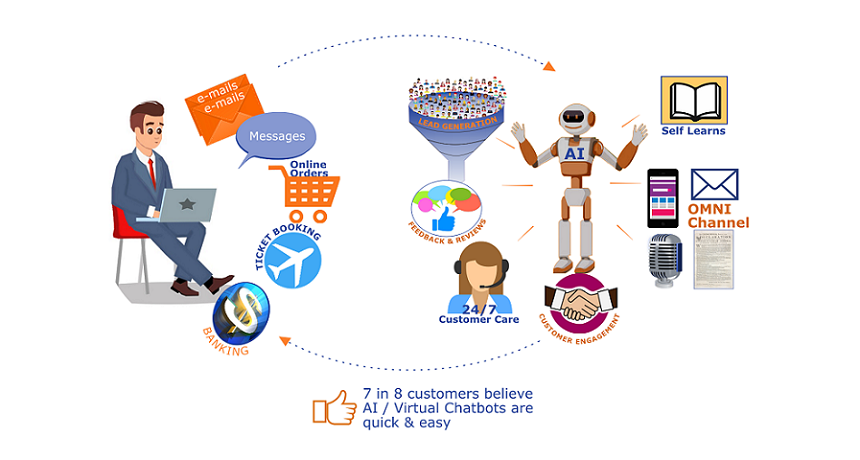A Chatbot is a traditional natural language interface that was originally designed for primary and linear-driven interactions that are rules-based. These chatbots can be built quickly and are guided by pre-defined workflows. Such type of chatbots have minimal application of AI or NLP technology.
Interestingly, research by Juniper says that chatbots will change the industry scenario for Healthcare and Banking sectors. It is expected that by 2022, 90% of customer queries would be handled by bots saving $8 billion per year incurred for customer support costs.
While rules-based chatbots could be part of these projections, nevertheless, true customer satisfaction in using chatbots will come from the ability of these chatbots to rightly identify the intents of the customer queries and thereafter, engage in a conversation that is atypical of a human agent. In other words, the ability of the chatbots to engage in a conversation with customers like humans.
Rules-based chatbots are rigid and can’t learn by themselves. They aren’t smart enough to understand the conversation and respond accordingly. In contrast, a chatbot that was built with a conversational AI could deliver this customer satisfaction.
Conversational AI refers to a combination of technologies like Machine Learning (ML), Natural Language Processing (NLP), Speech recognition, texts and other language technologies that allow machines to have human-like conversations. They help automate meaningful conversations and enhance the personalized customer experience.
Conversational AI tools enable long-term conversations through text, voice, and chatbots.
Why is Conversational AI important?
Conversational AI works by cutting down long or extensive sentences into origin level, as it has the ability to handle various traits of human language. It also can to recognize if there is any information or a command that needs to be analyzed.
Natural Language Processing (NLP) – an aspect of AI, allows machines to interpret human language by extracting intents (what a user wants) and entities (elements that helps in identifying user intent). While doing so, it looks for statistically considerable patterns that the machine is already trained to identify, along with some factors such as synonyms, canonical forms, grammar, slang, and more.
Conversational AI does more than you can imagine. A user can start a conversation in one channel and continue the same thread in another channel without losing conversation context or the communication flow.
Conversational AI can primarily transform an entire organization and its associated business units, as it provides more ways of interacting with customers and facilitates more robust communication and superior engagement.
Benefits of Conversational AI:
You can speak, write and chat with Conversational AI as it is readily available on voice-based devices, texting apps and online sites, and is omnipresent and seamless across several channels. You can use conversational AI through Alexa, Siri, Google Assistant or any other voice/text-based enterprise portal. Creating omnichannel interactions will prove to be the future of your business.
Self-Learning is a beautiful ability of a conversational AI. It uses the rich history and data available within the old enterprise solutions that include voice and text interactions, transcripts and other pre-existing data to learn and analyze. Later based on these learning, it can further suggest, converse, and even engage with customers.
Conversational AI’s have the ability to understand conversations and decipher the meaning of compound sentences in human speech in the same way as humans do. A usual human conversation has several factors like slang, multi-string words, abbreviations, emotions, long sentences, fragments and mispronunciations. Thus, conversational AI can both navigate and comprehend through these complicated conversations.
 You can have smart/intelligent conversations through Conversational AI as it knows who you are. It relates to your previous transactions and tries to join in where you left off. Now in the current world, it uses the same past conversations to interact further for smoother interactions. It also helps in troubleshooting and solves issues that occur during various processes like customer service, IT or invoice processing.
You can have smart/intelligent conversations through Conversational AI as it knows who you are. It relates to your previous transactions and tries to join in where you left off. Now in the current world, it uses the same past conversations to interact further for smoother interactions. It also helps in troubleshooting and solves issues that occur during various processes like customer service, IT or invoice processing.
 Conversational AI can make transactions supporting enterprise security concerns. It allows customers to enjoy seamless shopping experience beyond one click as it can handle complex transactions like purchasing life insurance, processing healthcare claims, troubleshooting internet issues or approving an invoice.
Conversational AI can make transactions supporting enterprise security concerns. It allows customers to enjoy seamless shopping experience beyond one click as it can handle complex transactions like purchasing life insurance, processing healthcare claims, troubleshooting internet issues or approving an invoice.
 Conversational AI works 24/7 and responds instantly as they answer queries rapidly and resolve issues quickly by promoting more lead conversions. You can avoid a negative review as conversational AI’s can interact right on time.
Conversational AI works 24/7 and responds instantly as they answer queries rapidly and resolve issues quickly by promoting more lead conversions. You can avoid a negative review as conversational AI’s can interact right on time.
Conversational AI helps in minimizing costs by improving service protocols, deflection, and enhances operational competence.
You can generate valuable insights through conversational AI as it uncovers voice of the customer, analyses it and responds accordingly.
 Conversational AI improves productivity by performing various support functions, automate processes, and streamlines regular manual tasks.
Conversational AI improves productivity by performing various support functions, automate processes, and streamlines regular manual tasks.
As conversational AI can be applied from corner to corner in an organization across regions, it can help both customers and employees to scale infinitely.
Conversational AI has some uniqueness to it when compared to regular voice-based assistants. Organizations using conversational AI can provide users with a more personalized experience while interacting with machines. Conversational AI involves understanding and analyzing human emotions through sentiment analysis and continuous machine learning by accessing both structured and unstructured data.
Smart and intelligent conversational interfaces help businesses to create superior interactions with everyone in the entire supply chain, including employees, customers and suppliers, in-house devices. It helps in aligning all the business units together at one place driving better customer engagement enhancing more productivity. Soon we shall see a shift in how, when, where, and with whom we communicate. Now through conversational AI users can have short conversations like a single query or a request or long conversations where a user expects a right answer from the company. Times are changing, and companies need to embrace the new change and start adopting conversation AI as the top priority.

